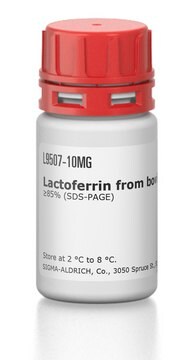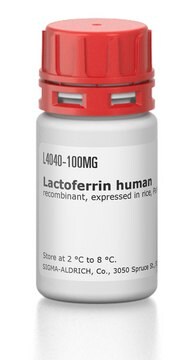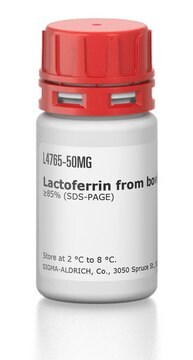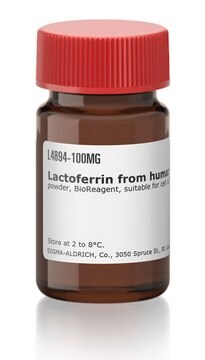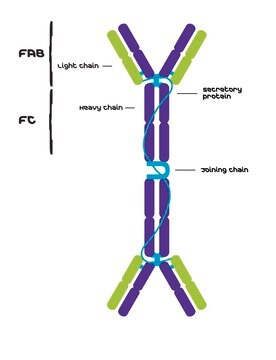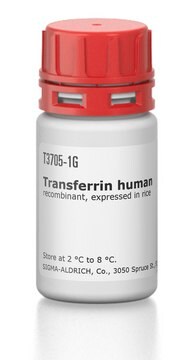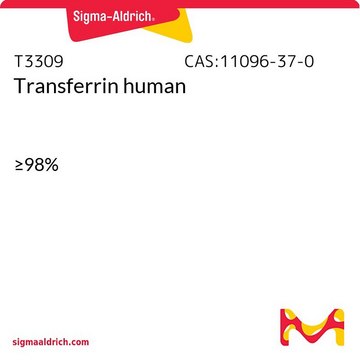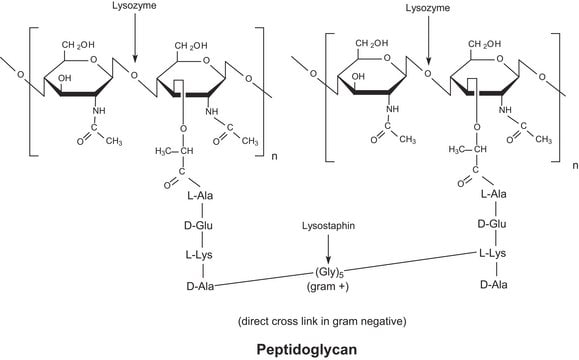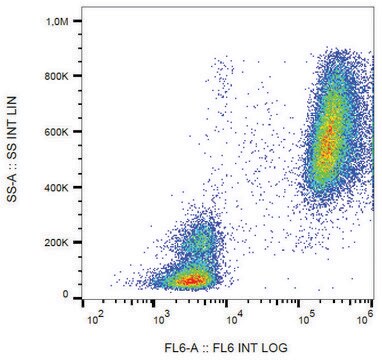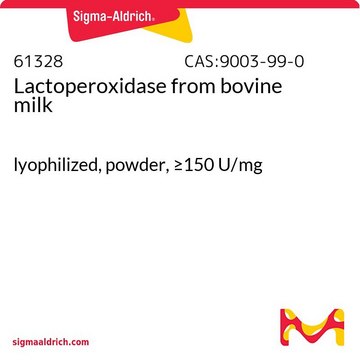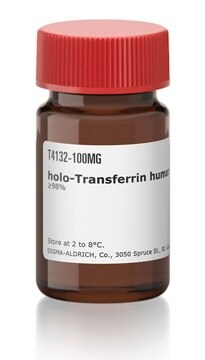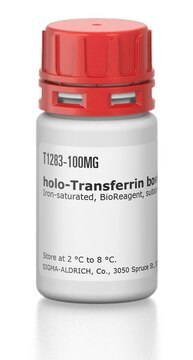L1294
Lactoferrin human
recombinant, expressed in rice, Iron saturated, ≥90% (SDS-PAGE)
Sinónimos:
Holo Transferrin
Iniciar sesiónpara Ver la Fijación de precios por contrato y de la organización
About This Item
Productos recomendados
biological source
human
recombinant
expressed in rice
type
for cell culture
assay
≥90% (SDS-PAGE)
≥90% (biuret)
form
powder
technique(s)
microbiological culture: suitable
impurities
≤10 EU/mg endotoxin
UniProt accession no.
storage temp.
2-8°C
Gene Information
human ... LTF(4057)
¿Está buscando productos similares? Visita Guía de comparación de productos
Application
Lactoferrin was used to grow Streptococcus mutans in an iron-limiting medium. It was used to test if lactoferrin impedes epithelial cell adhesion in vitro.
Biochem/physiol Actions
Lactoferrin is an iron binding protein. It is structurally similar to transferrin, the plasma iron transport protein; but lactoferrin has a much higher affinity for iron (250 fold). It is very abundant in colostrum and small amounts can also be found in tears, saliva, mucous secretions and in the secondary granules of neutrophils. It is made by mucosal epithelium and neutrophils and is released by these cells in response to inflammatory stimuli. Bacterial growth is inhibited by its ability to sequester iron and also permeabilize bacterial cell walls by binding to lipopolysaccharides through its N-terminus. Lactoferrin can inhibit viral infection by binding tightly to the viral envelope protein. This prevents cell-virus fusion by blocking the binding domain. Lactoferrin appears to activate host defense systems in part by stimulating the release of interleukin-8, a neutrophil activator. It may also be involved in antibody and interleukin synthesis, lymphocyte proliferation and complement activation.
Storage Class
11 - Combustible Solids
wgk_germany
WGK 3
flash_point_f
Not applicable
flash_point_c
Not applicable
ppe
Eyeshields, Gloves, type N95 (US)
Elija entre una de las versiones más recientes:
¿Ya tiene este producto?
Encuentre la documentación para los productos que ha comprado recientemente en la Biblioteca de documentos.
Los clientes también vieron
N Huang et al.
In vitro cellular & developmental biology. Animal, 44(10), 464-471 (2008-09-20)
Today there is a concern about the use of animal source proteins and peptides in cell culture applications due to potential contamination by adventitious infectious pathogens. Recombinant production of these proteins using a plant host provides a safe and cost
Erwann Rousseau et al.
Molecular pharmacology, 84(6), 888-898 (2013-10-01)
Previous studies on postmortem human brain tissue have shown that the iron-binding glycoprotein lactoferrin is upregulated in dopamine (DA) neurons resistant to degeneration in Parkinson disease (PD). To study how this could possibly relate to disease progression, we used midbrain
Ling Tang et al.
Wound repair and regeneration : official publication of the Wound Healing Society [and] the European Tissue Repair Society, 18(1), 123-131 (2010-01-20)
Human lactoferrin (hLF), a glycoprotein of the transferrin family, has recently been shown to stimulate wound repair through its antimicrobial effect and inflammation modulation. A recent study with several non-skin cell lines indicated that hLF may also have a stimulatory
Qingsheng Kong et al.
Molecular and cellular biochemistry, 406(1-2), 293-299 (2015-05-20)
The metalloprotease lethal factor (LF) from Bacillus anthracis plays a vital role in anthrax toxin action, and thus becomes a target for anti-anthrax therapy. Following the guidelines based on existing metalloprotease inhibitors, we designed a 'first-generation' LF inhibitor R9LF-1. This
Esmat Aly et al.
Food research international (Ottawa, Ont.), 118, 101-107 (2019-03-23)
This study aimed to evaluate the potential anti-inflammatory role of the most produced form of lactoferrin expressed in various expression systems (Fe-saturated recombinant human Lf, rhLf) and its hydrolysate in concentrations resembles that found in mature human milk. Co-culture model
Nuestro equipo de científicos tiene experiencia en todas las áreas de investigación: Ciencias de la vida, Ciencia de los materiales, Síntesis química, Cromatografía, Analítica y muchas otras.
Póngase en contacto con el Servicio técnico